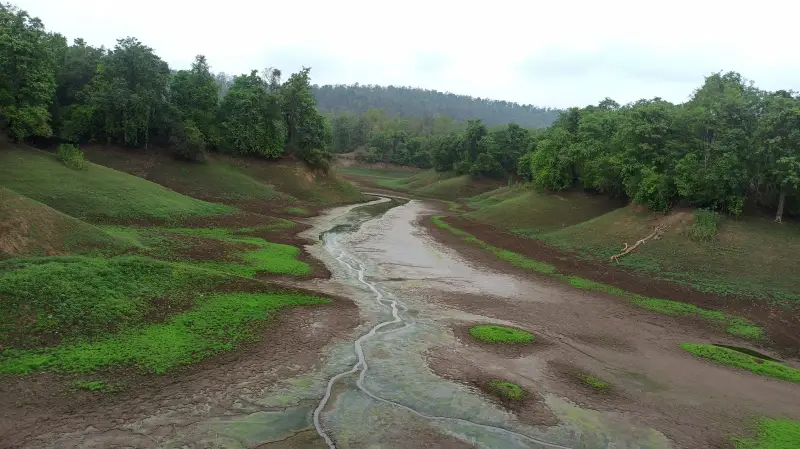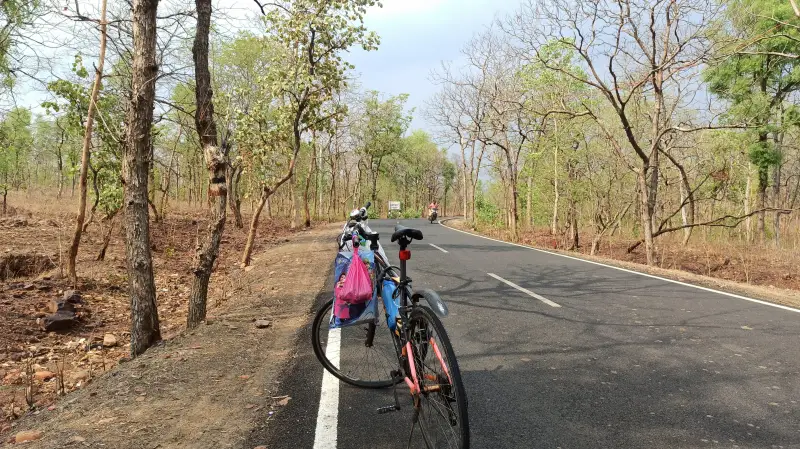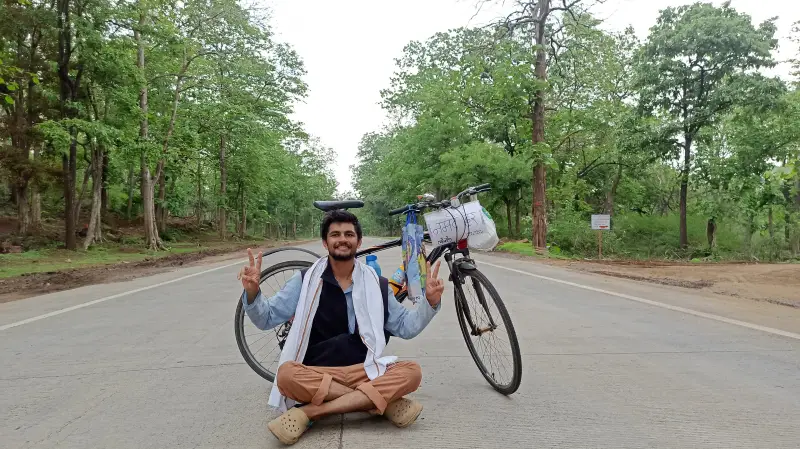- This topic is empty.
- AuthorPosts
- 26/08/2022 at 14:28 #7264
Mitesh from Gujarat completed the Narmada Parikrama on a bicycle and shares his experience of this incredible and blessed journey…

Mitesh with his frugally laden bicycle “नर्मदे हर भैया! नज़दीक में परिक्रमावासी के लिए कोई आश्रम है क्या? मैं गुजरात से आया हूँ। साइकिल से परिक्रमा के लिए निकला हूँ!”
This was the most common phrase that I spoke during the 25 days of “Narmada Parikrama.”
Parikrama in the literal sense means “circumambulation”; meaning you come back from where you started.
I was always passionate about cycling. I made sure that only my activities that exceeded 50 kilometres went into my Strava profile. Not to exaggerate, but I never wanted the label of “cyclist” as everybody visualises – someone with cycling clothes, gloves, helmet, glasses, saddle bags and hydration backpacks. I kept it simple. My list of accessories included nothing more than the front and rear cycle lights that Ami gifted.
The seed of the parikrama was sown a year back with the thought of “adventure” as the sole purpose when I first rode along the northern banks of river Narmada. I rode solo from Mithi talai to Garudeshwar for four days. It was then that my whole perspective about Parikrama changed. I swore to myself to complete the parikrama of river Narmada after getting my MBBS internship done.
Narmada Parikrama on a Bicycle
Narmada River (often referred to as “Maa Narmada”) is one of the main rivers of India. The total length of the river from its source (Amarkantak) to the sea (Arabian sea) is 1312 kilometres. Some mythological stories say that – the Narmada River originated from the perspiration of Shiva when he was in a deep meditative state. There are other interesting stories too. But to emphasise just one fact – it is the only river in the world, whose parikrama is done.
I usually tend to implement my thoughts quite readily when it has this “adrenaline” component. It was 21st June 2022 when I began my parikrama from Garudeshwar, the place where I ended my ride a year back. In ancient times and even today, some people believe that parikrama should be started from Omkareshwar for it produces more results. Little did I know that there were a set of rules for parikrama too. I’m glad they became more and more lenient over the decades.

Some rules of parikrama that are meant to be followed:
- During parikrama, maa Narmada should always be on the right side of parikramavasi (one who does parikrama).
- Parikrama can be done between sunrise and sunset only.
- Parikramavasis should attend Narmada maa’s aarti in the morning and evening after taking a bath in the river.
- It is not allowed to cross the river during parikrama.
- Parikramavasis should chant “Narmade har” on every step.
- They should walk barefoot.
- They cannot carry cooked food or money. They are allowed to carry utensils and some raw food materials to cook on their own or can ask for bhiksha (alms).
- They are not allowed to get angry.
- They have to carry a stick.
- They are not allowed to wear stitched clothes. They have to wear white lungi / langot/ vastra.
To be honest, I couldn’t follow the above rules. But I did follow:
- Riding cycle between sunrise and sunset.
- Never crossed the river even if it meant riding some extra kilometres.
- Stayed at ashram or home for parikramavasis throughout.
I started my parikrama at 6:30 am from Garudeshwar by taking Narmada jal (water from the river) in a tiny bottle. Initially, there was this unusual fear of maintaining spirituality and sacredness. But my pedal was moving fast. After a couple of days, it became a part of my subconscious mind to start my ride at 6:30 am and target to cover 100-120 km before 7 pm.
Without undue pressure and my faith in Narmada maa that kept growing, I was effortlessly able to achieve my everyday targets. I can’t describe in words, the kind of pleasure that I experienced in taking a bath in the river every evening at the everyday destinations and then attending the aarti. Aarti followed by a light dinner, a routine mandatory call to Jyotiben and then a good sleep.
I am a nature lover. And nature didn’t fail to impress, as always, in terms of the hills, the valleys, the dense forests, the rains, and the mesmerising river course. The fragrance of freshly decomposed leaves, the chirping birds and the strong sun rays worked as fuel for me and my cycle. I travelled through all types of roads – straight and hairpin loops, highways and earthen roads, plain and hilly. Along the journey – I kept chanting…
।। त्वदीय पादः पंकजम, नमामि देवी नर्मदे।।
It was the tenth day of parikrama when I was able to reach Shahpur. Amarkantak (the origin of the river) was 117 km away from there and my excitement grew. I visited two shivlings (at Jaleshwar & Amareshwar) along the way. The roads were hilly and surrounded by dense forest. At times, I was talking with myself and I was singing out loud, because there was no one to say “hi”. Sometimes, I’d pour my mind and heart out to the cycle. My bicycle is such a good listener. Not a single chai stall nor trespasser.
The thrill, me and my cycle experienced down the slope with light rains overhead, was exhilarating. It was on the eleventh day after riding 1150 km that I reached Amarkantak, completing the ride over the northern banks of the river. Some distance was covered off the saddle seat and some on the saddle. The weather outside changed as well as inside me. I laughed out aloud! What an amazing feeling! (More exclamation marks, intended).
I left Mrityunjay Ashram at Amarkantak where I rested for a day, to reach Narmada Kund, Maiya ki Bagiya (actual origin of river Narmada) which is around 2 km away from Amarkantak. Here is where the switch from North bank to South bank happens after some rituals.

Cyclists’ Sustenance: Biscuits & Chai On 3rd July, I started my ride over the Southern bank of the river with a loud chant of “Narmade har” after the rituals. I had to reach Vamleshwar, the place over the southern bank where the Narmada River disappears into the Arabian sea. According to mythology and Narmada Puran, every parikramavasi after reaching Vamleshwar has to cross the river in a ferry boat to reach the opposite bank. (Mithi talai).
It took me eleven days to reach Vamleshwar from the origin and the monsoon had set in hard in Gujarat. Ferry boats do not function during the monsoon for at least 4 months. In order to reach Mithi talai, I rode via road from Vamleshwar > Bharuch > Dahej > Mithi talai. I was left with my final trail from Mithi talai to Garudeshwar, the place from where I began parikrama.
I literally cried in front of my bicycle, after having ridden it on the worst to the best of roads. It didn’t give up. I couldn’t express my gratitude to it for what it had done for me. At the end of Parikrama, I was feeling very light – not in terms of losing weight but that feeling of excluding unnecessary elements and clutter from the mind. In the end, I just want to say one thing: THIS WAS THE JOURNEY OF FUN AND FEAR WHICH WAS FUELED BY FAITH, FAITH IN SUPREME POWER CALLED NATURE.
Along the way, two surprises happened. One – my Strava ride crashed on the 23rd day of the ride. Two – my parents came to celebrate with me on the last day, 2 km before the completion of my parikrama. My parents must have thought in their mind – “Hey nomad! Enough of it. Let’s take you home now.”
It was my attempt to thank the lifeline of mankind river Maa Narmada. Thank you maa Narmada, Jyotiben and my dear cycle.
You can check out my video on this YouTube link:
Memories from the Road:
Along my journey of 25 days, I met some parikramavasis. One among them was a father-son duo with whom I had an elaborate conversation for more than 5 hours straight.
Uncle was at a well-reputed post in HSBC with a salary of at least 1.8 lacs/month. He sought to take early retirement to live this sort of life. During our conversation, we exchanged our perspectives about parikrama being scientific and that made our conversation worth sharing…
- When you walk or ride constantly for so many days, it becomes like meditation. It sets you free.
- You follow the same schedule every day and that makes you disciplined.
- You meet various kinds of people; rich and poor, good and bad. You learn the basics of humanity and harmony.
- You wear white clothes because they keep you cool in the sun.
- You have only “satvik bhojan” (balanced diet), which is good for your digestive system.
- You walk or ride which keeps you physically fit.
- You stay in nature throughout the day, take a bath at the river, perform/ attend aarti, meet saints, and learn spirituality – in all it makes you mentally fit.
He exchanged our last “Narmade har” followed by his best wishes saying- “Hey Gujju! I’m sure you’ll come back here for parikrama one more time but then by foot.” I couldn’t resist smiling.
Jyoti ben (chalti-firti Narmada)
She’s a wonder woman. Without her, even the thought of Parikrama would not have been possible. I first met her during my solo ride along the banks of river Narmada, a year ago. She asked me a very interesting question to explain to her the difference between a “monk” and a “saint”. She made it clear that monks are those who do not leave their social life. They do not sacrifice their living, their possession or their family to live in a spiritual world. They reform themselves internally, to be pure. I was dumbstruck.
She’s the “Yellow pages” of Narmada parikrama. She knows about each and every village, every shivling, every religious or mythological stories related to it, and every ashram and sadhu swami as well, all along the way. People call her चलती फिरती नर्मदा.
It became my routine to call her every night after dinner to ask for the next day’s schedule – route, ashram and must-visit places and her name worked magically at every place that I visited. I used to call her in the evening to let her know about the updates and she’d pick up the phone saying ” છોકરા બોલ, કેટલે પહોંચ્યો?”. And these words really worked like a therapy for me.
I might have missed calling my parents every day but I never forgot to call Jyotiben. She was like a chosen mom for me, and always spoke with a positive tone. She often mentions me to her neighbours during our calls saying “કે એક મેડિકલ નો વિદ્યાર્થી સાઇકલ લઈને એકલો પરિક્રમા કરવા નીકળ્યો છે અને રોજ મને આમ ફોન કરીને બધી વાત કરે.” More than 95% parikramavasis have completed their parikrama with her blessings. I can say without a doubt that she is a monk. She is a સિદ્ધઆત્મા.

Left – Jyotiben, Right – Shashiben (Jyotiben’s aunty) Being solo:
Wherever I stopped for tea or at an ashram or at home, one question that would commonly pop up is ” Where are your companions? You could have convinced at least one to accompany you! ” My only answer would be a laugh. There’s a huge difference between being alone (solo) and being lonely. I’d leave it for you to ponder upon it.
Being solo is a part of my nature; not that I don’t enjoy the company. During parikrama, being solo helped me a lot. Every morning after waking up, riding a bicycle on unknown roads was a thrill. Tears, sweat and unexplored places made me humble. The sun, the stars and the moon were the constant source of my energy throughout the journey. Nature teaches you everything, provided you take the time out to be with it.
The Essence of Parikrama:
Parikrama can be compared to the story of evolution. Our civilisation flourished at river banks and for us to flourish in the present century, it is essential for us to go back to it. You commence the journey with nothing in hand, you look into the past, your actions, and your beliefs to mould your future.
Text & Photos: Mitesh Modi
If you enjoyed reading Mitesh’s Narmada Parikrama on a Bicycle, then also read, Single Speed Touring with a Fakir! And read Vignesh’s journey from Jammu to Kanyakumari…
- AuthorPosts
- You must be logged in to reply to this topic.









